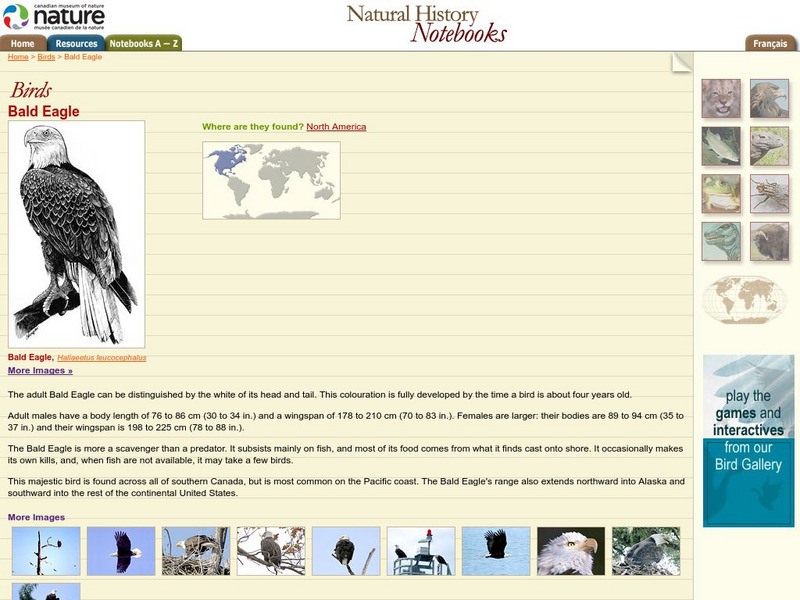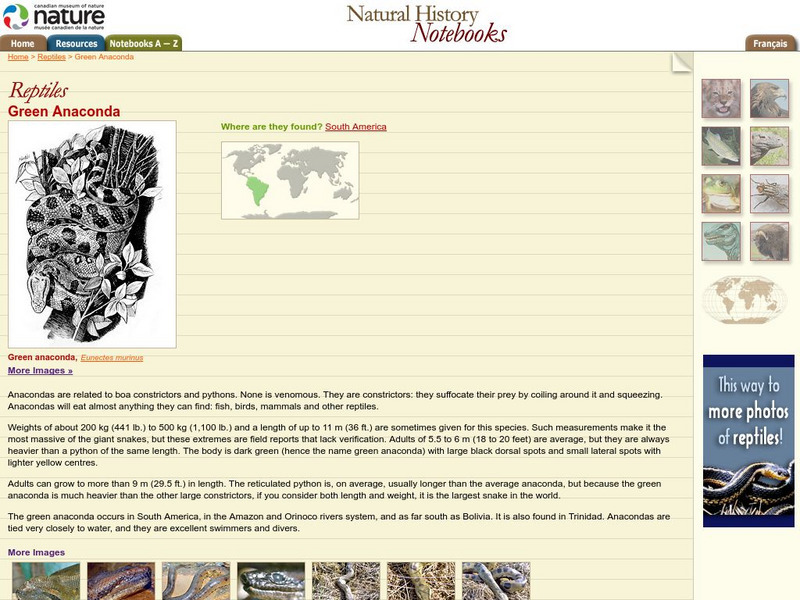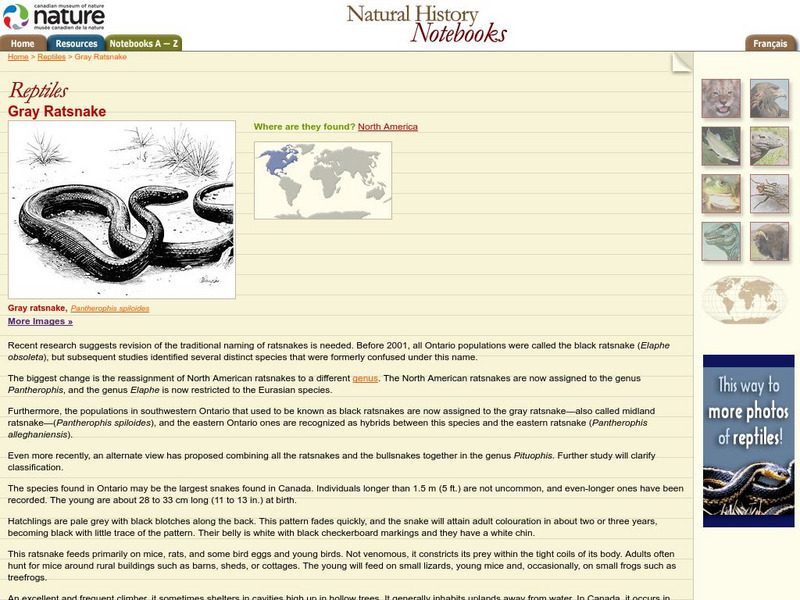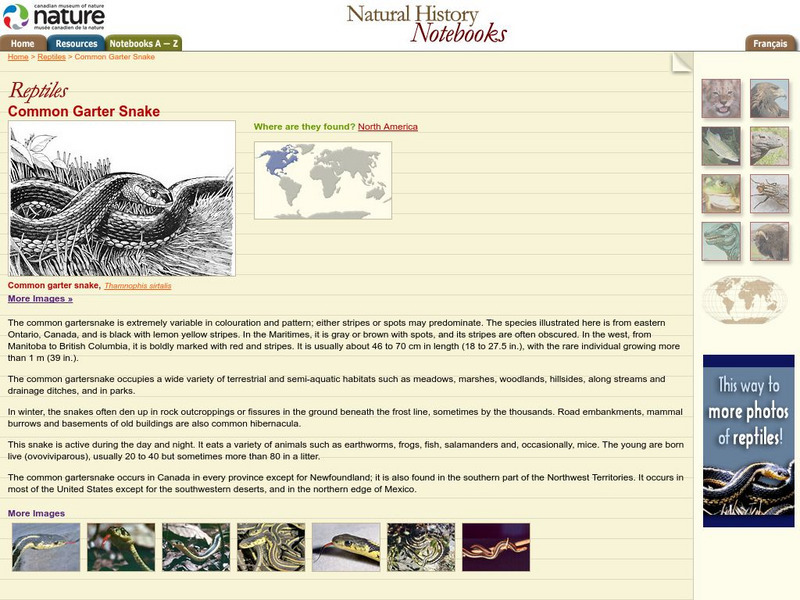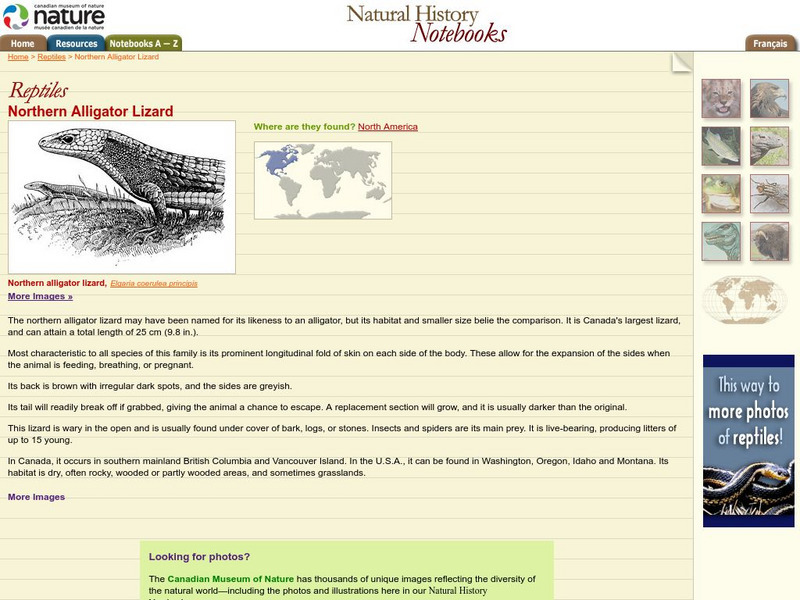Canadian Museum of Nature
Canadian Museum of Nature: Bactrian Camel
Bactrian camels are found wild in the Gobi Desert, and in the grasslands of China and Mongolia. Details about this animal can be found here along with photos.
Canadian Museum of Nature
Canadian Museum of Nature: Brown Rat
Brown rats are the ones that can carry diseases to humans and are loathed and feared by many. Details about this animal can be found here.
Canadian Museum of Nature
Canadian Museum of Nature: Northern Leopard Frog
Here, the Northern Leopard Frog, a popular frog throughout North America, is described in succinct detail.
Canadian Museum of Nature
Canadian Museum of Nature: Great Auk
A profile of the extinct Great Auk is provided here by the Canadian Museum of Nature.
Canadian Museum of Nature
Canadian Museum of Nature: Bobcat
Bobcats are sometimes confused with lynxes but are smaller and have more spots. Some facts and pictures can be found here.
Canadian Museum of Nature
Canadian Museum of Nature: Common Nighthawk
Briefly described are the location and characteristics of the Common Nighthawk. Nine excellent photographs are also included.
Canadian Museum of Nature
Canadian Museum of Nature: Common Loon
The Common Loon is the provincial bird of Ontario. Described are it's characteristics, offspring, and migratory patterns. Ten beautiful images capture this majestic bird in its environment.
Canadian Museum of Nature
Canadian Museum of Nature: Black Capped Chickadee
Have you heard the bird call, "Chicka-dee-dee-dee"? This familiar call belongs to New Brunswick's provincial bird. Briefly described are its song, features, food and habitat. Included are ten beautiful close up photographs.
Canadian Museum of Nature
Canadian Museum of Nature: Barn Swallow
Briefly described are the characteristics, food, and habitat of the Barn Swallow. Included are ten beautiful photographs.
Canadian Museum of Nature
Canadian Museum of Nature: American White Pelican
Did you know that the awkward looking pelican is very graceful in flight? Briefly described are its features, habitat and young. Seven excellent photographs showcase this bird in its environment.
Canadian Museum of Nature
Canadian Museum of Nature: American Robin
The robin usually signals the arrival of spring in Canada. This brief description of the robin includes ten excellent pictures of the bird and its young.
Canadian Museum of Nature
Canadian Museum of Nature: Bald Eagle
Described, briefly are the Bald Eagle's characteristics, food and location. Ten beautiful photographs showcase this majestic bird.
Canadian Museum of Nature
Canadian Museum of Nature: Anaconda
Did you know that a full grown Anaconda can weigh as much as 200 K g (441 lb.)? This is just one of the interesting facts that describe this reptiles features and habitat. Seven photographs provide excellent close up views.
Canadian Museum of Nature
Canadian Museum of Nature: Gray Ratsnake
Previously known as black ratsnakes, the gray ratsnake is one of the largest snakes found in Canada. Described are its characteristics, young and food.
Canadian Museum of Nature
Canadian Museum of Nature: Garter Snake
Did you know that the common garter snake can be found in every province in Canada, except Newfoundland? This is just one of the interesting facts presented along with eight close up photographs.
Canadian Museum of Nature
Canadian Museum of Nature: Boa Constrictor
The boa constrictor is not venomous, but kills its pray by constriction. Described at the boa constrictor's characteristics, young, habitat and pray. Included is one close up image.
Canadian Museum of Nature
Canadian Museum of Nature: Northern Alligator Lizard
The northern alligator lizard is Canada's largest lizard. Described are its characteristics, and habitat.
Canadian Museum of Nature
Canadian Museum of Nature: Indian Gavial
The Indian gavial is one of the rarest crocodile species in Asia. Described at its characteristics, young. Included is one photograph.
Canadian Museum of Nature
Canadian Museum of Nature: Galapagos Land Inguana
Today, very few of the Galapagos land iguanas exist. Described are their characteristics, food, and reproduction. Eight photographs show this iguana close up in its habitat.
Canadian Museum of Nature
Canadian Museum of Nature: Crocodiles
Do you know the difference between a crocodile and an alligator? Find out how they differ, the number of species, what they eat, their characteristics and location. Six pictures show this reptile in its habitat.
Canadian Museum of Nature
Canadian Museum of Nature: American Alligator
Did you know that there are 21 crocodilian species? This is just one of the interesting facts that describe the alligator's features, habitat, and young. Ten close up photographs provide for an exciting look at this amazing reptile.
Canadian Museum of Nature
Canadian Museum of Nature: Dovekie
The Dovekie, also known as a little auk, is a small black and white sea bird that inhabits the Arctic and Northern Atlantic oceans. Briefly described are the locations it may be found in and its characteristics. Included are two close up...
Canadian Museum of Nature
Canadian Museum of Nature: Yellow Bellied Sapsucker
Briefly described are the characteristics and feeding habits of the Yellow-bellied Sapsucker. This is of one of the few species of migratory woodpeckers. Two pictures provide a close up view.
Canadian Museum of Nature
Canadian Museum of Nature: Leeches
Leeches are found all over the world in both fresh and salt water, yet people tend to know little about them. Some facts and photos of these misunderstood creatures are found here.













